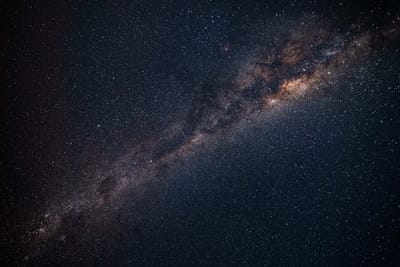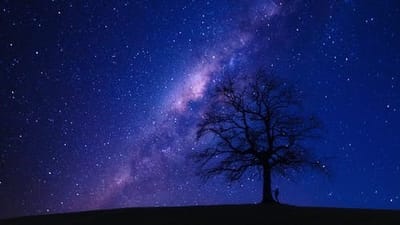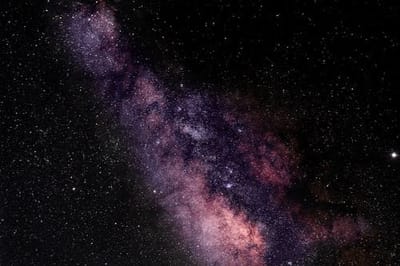Norse Constellations of stars
Tegedao som Skandinav är det naturligt att tänka om 'Norse mythology' och stjärnkonstellationer. Framför allt när det gäller 'the mastery' av 'the Norse' navigation och 'seamanship' i Vikinga-drakbåtar som krävde kunskap av astronomi. Observationer av stjärnorna och solen var viktigt för navigation och för att hålla koll på tiden ute till sjöss.
'The Norse' hade sina egna konstellationer och namn för stjärnorna. När dem vände blicken upp till den stjärnfyllda himlen, upp emot 'the mythical realm of the gods'. Många myter skrivna i stjärnorna
Världsträdet Yggdrasil - världens största träd vars grenar täcker hela himlen och där gudarna samlas dagliga till ting.
Men detta magnifika Världsträd Yggdrasil - sträcker sig också till stjärnorna som är frukt på dem utsträckta grenarna, och Vintergatan dess massiva rötter som sträcker sig ner till Jorden! Vintergatan (The Milky Way) ansågs vara vägen till 'the other world' som 'the Norse' kallade för Bifrost där Vintergatan var vägen till 'the underworld'.
I Völuspa från Snorre Sturlason’s Edda – är ursprunget av stjärnorna är nämnda, och även dess slut i Ragnarök. Världen skapades från kroppen av jätten Ymer. Hans skalle formade himlavalvet och vaktas av fyra dvärgar, där gnistor från Muspelheim formar stjärnorna. Deras plats i skyn bestämdes av gudarna och vissa blev givna ’paths they will roam’. En annan legend handlar om Aurvandil – som far igenom frusna ’wastelands’ med ’the Norse god’ Thor. När de båda kom fram till isiga Élivágar floden, Thor erbjöd att bära Aurvandil på sin rygg i en korg. Men en av Aurvandil tå stack ut från korgen och tån frös till is. Thor tog loss den och kasta den upp till skyn, där den finns än idag – en kall skinande stjärna! Aurvandils-tá! För övrigt, den mest skinande stjärnan på natthimlen, främst känd som Sirius, kallades ’Lokabrenna’ av ’the Norse’ som betyder ’Lokis fakla’. Loki en annan känd figur i ’Norse myth’
Spirits in the sky! Till exempel de svarta korparna av 'the Norse folktale', reflekterad som de 'celestiala' fåglarna Cygnus och Aquila. Eller hunden med sina brinnande ögon är hunden av 'the underworld' - hunden från Hel - som uppenbarar sig i en konstellation i form av en 'fiery red star'. Eller 'the mouth of the wolf i Andromeda - stjärnor i Pisces. Andra stjärnor är; Arcturus - Dagstjarna, Polaris - Leidarstjarna, Vega - Sudrestjarna
Stjärnor var helt enkelt för 'the Norse' inte bara om astronomi och om att navigera ute till sjöss i Vikinga-drakbåtar! Stjärnorna användes som en metafor för att förstå världen bortom vår egen, som är mer spirit! 'Star maps' som språk av naturen! The language of the heavens’ för att förmedla deras antika mening till oss även I detta ögonblicket. Förenandet med oss genom att titta upp på natthimlen och få känslan att du är ’connectad’ till de större kosmos som är där ute
Är det en tillfällighet att folk i en 'psychedelic' upplevelse - LSD eller magiska svampar - som kombinerar det med 'stargazing' har rapporterat seendes linjer från stjärnorna som en 'interconnected web'!? Dem kanske har lokaliserat ’the Norse Star Constellations’!?
--
The Norse mythology, rich in its narrative depth and cosmological significance, presents a fascinating view of the universe. Among its many intriguing aspects, the constellations, as perceived through the lens of holographic deities, offer a unique perspective on how the ancients might have conceptualized the night sky and its celestial inhabitants. This article explores the Norse mythological constellations from the standpoint of these holographic gods and goddesses, beings of light and energy that form and inhabit the heavens. In imagining a universe where the constellations are not just passive collections of stars but active, dynamic entities—holographic gods and goddesses—we enter a realm where mythology and cosmology intertwine. These divine figures, constructed from the very fabric of the cosmos, manifest themselves across the night sky, telling stories, guiding, and influencing the lives of the Norse people below. At the heart of this celestial narrative is Yggdrasil, the World Tree, an immense ash tree that is central to Norse cosmology. Viewed from a holographic perspective, Yggdrasil transcends physical dimensions, connecting the nine worlds of the Norse universe through its branches and roots. The tree itself could be seen as a constellation, its branches stretching across the sky, linking the stars and the realms they represent. Each world hanging from Yggdrasil's branches—Asgard, Midgard, Jotunheim, among others—could be associated with specific star clusters, their tales woven into the fabric of the cosmos.
The Valkyries, warrior maidens who serve Odin, are depicted as riding through the heavens, choosing those who will die in battle and those who will live. In a holographic universe, the Valkyries' movements across the sky could be represented by meteor showers or comets, their ethereal forms shimmering among the stars. These celestial phenomena, then, become messages or omens, direct communications from the gods to the people below.
Odin, the Allfather, sacrificed one of his eyes at Mimir’s well for wisdom. In our celestial narrative, this eye could be represented by Polaris, the North Star. Polaris, standing almost motionless in the sky, serves as a beacon of guidance and wisdom. From a holographic standpoint, Odin's eye watches over the realms, a constant, unblinking presence that orients the Norse people in both a literal and metaphorical sense. Thor, the thunder god, wields Mjölnir, a hammer of great power. In the starry tapestry, Mjölnir could be symbolized by the constellation of Orion’s Belt. The three bright stars that form the belt could be seen as different aspects of Mjölnir's might—its power to protect, its ability to bring fertility with rain, and its role as a weapon against the giants. The holographic Thor, then, battles in the heavens, his struggles and victories reflected in the changing patterns of the stars. Freyja, the goddess of love, beauty, and fertility, wept tears of gold for her absent husband, Óðr. These tears, when they touched the Earth, turned into gold, but in the heavens, they became the star cluster known as the Pleiades. This beautiful, tight cluster of stars, glowing softly in the night sky, represents Freyja's eternal love and longing. The holographic Freyja, her essence dispersed across the cosmos, reminds the viewer of the interconnectedness of love, loss, and the celestial dance. Ragnarök, the prophecy of the gods’ downfall and the rebirth of the world, plays out across the heavens in dramatic fashion. Constellations clash, stars fade and rekindle, symbolizing the death of gods and monsters alike, followed by the emergence of a new world from the cosmic sea. This cyclic nature of destruction and creation, viewed through a holographic lens, emphasizes the Norse belief in the eternal return, the endless cycle of birth, death, and rebirth, not just of the world but of the stars themselves.
Viewing the Norse constellations as expressions of holographic gods and goddesses allows for a profound reimagining of the night sky. These celestial beings, composed of light and the very substance of the universe, narrate epic tales of heroism, love, sacrifice, and renewal. Through their movements, interactions, and the changing patterns they form, they convey the rich tapestry of Norse mythology, making the heavens a living, breathing entity, vibrant with stories that resonate across the ages. This perspective not only enriches our understanding of Norse cosmology but also invites us to look up at the night sky with renewed wonder, seeing in its constellations the enduring power of myth to shape our understanding of the cosmos.
The Norse mythological constellations, envisioned as holographic gods and goddesses, present a breathtaking tapestry in the night sky, where celestial phenomena embody the epic narratives of Norse mythology. This perspective transforms the heavens into a dynamic stage where the sagas of deities, heroes, and mythical creatures are played out across the stars. The constellations, more than mere clusters of light, become living, breathing entities, each telling a story of power, sacrifice, and rebirth. This holographic(HOLOSOPHY) view not only deepens our connection to the ancient myths but also infuses the night sky with a profound sense of awe and wonder, as every star and constellation weaves into the rich, unfolding narrative of the universe itself.
'The Norse' hade sina egna konstellationer och namn för stjärnorna. När dem vände blicken upp till den stjärnfyllda himlen, upp emot 'the mythical realm of the gods'. Många myter skrivna i stjärnorna
Världsträdet Yggdrasil - världens största träd vars grenar täcker hela himlen och där gudarna samlas dagliga till ting.
Men detta magnifika Världsträd Yggdrasil - sträcker sig också till stjärnorna som är frukt på dem utsträckta grenarna, och Vintergatan dess massiva rötter som sträcker sig ner till Jorden! Vintergatan (The Milky Way) ansågs vara vägen till 'the other world' som 'the Norse' kallade för Bifrost där Vintergatan var vägen till 'the underworld'.
I Völuspa från Snorre Sturlason’s Edda – är ursprunget av stjärnorna är nämnda, och även dess slut i Ragnarök. Världen skapades från kroppen av jätten Ymer. Hans skalle formade himlavalvet och vaktas av fyra dvärgar, där gnistor från Muspelheim formar stjärnorna. Deras plats i skyn bestämdes av gudarna och vissa blev givna ’paths they will roam’. En annan legend handlar om Aurvandil – som far igenom frusna ’wastelands’ med ’the Norse god’ Thor. När de båda kom fram till isiga Élivágar floden, Thor erbjöd att bära Aurvandil på sin rygg i en korg. Men en av Aurvandil tå stack ut från korgen och tån frös till is. Thor tog loss den och kasta den upp till skyn, där den finns än idag – en kall skinande stjärna! Aurvandils-tá! För övrigt, den mest skinande stjärnan på natthimlen, främst känd som Sirius, kallades ’Lokabrenna’ av ’the Norse’ som betyder ’Lokis fakla’. Loki en annan känd figur i ’Norse myth’
Spirits in the sky! Till exempel de svarta korparna av 'the Norse folktale', reflekterad som de 'celestiala' fåglarna Cygnus och Aquila. Eller hunden med sina brinnande ögon är hunden av 'the underworld' - hunden från Hel - som uppenbarar sig i en konstellation i form av en 'fiery red star'. Eller 'the mouth of the wolf i Andromeda - stjärnor i Pisces. Andra stjärnor är; Arcturus - Dagstjarna, Polaris - Leidarstjarna, Vega - Sudrestjarna
Stjärnor var helt enkelt för 'the Norse' inte bara om astronomi och om att navigera ute till sjöss i Vikinga-drakbåtar! Stjärnorna användes som en metafor för att förstå världen bortom vår egen, som är mer spirit! 'Star maps' som språk av naturen! The language of the heavens’ för att förmedla deras antika mening till oss även I detta ögonblicket. Förenandet med oss genom att titta upp på natthimlen och få känslan att du är ’connectad’ till de större kosmos som är där ute
Är det en tillfällighet att folk i en 'psychedelic' upplevelse - LSD eller magiska svampar - som kombinerar det med 'stargazing' har rapporterat seendes linjer från stjärnorna som en 'interconnected web'!? Dem kanske har lokaliserat ’the Norse Star Constellations’!?
--
The Norse mythology, rich in its narrative depth and cosmological significance, presents a fascinating view of the universe. Among its many intriguing aspects, the constellations, as perceived through the lens of holographic deities, offer a unique perspective on how the ancients might have conceptualized the night sky and its celestial inhabitants. This article explores the Norse mythological constellations from the standpoint of these holographic gods and goddesses, beings of light and energy that form and inhabit the heavens. In imagining a universe where the constellations are not just passive collections of stars but active, dynamic entities—holographic gods and goddesses—we enter a realm where mythology and cosmology intertwine. These divine figures, constructed from the very fabric of the cosmos, manifest themselves across the night sky, telling stories, guiding, and influencing the lives of the Norse people below. At the heart of this celestial narrative is Yggdrasil, the World Tree, an immense ash tree that is central to Norse cosmology. Viewed from a holographic perspective, Yggdrasil transcends physical dimensions, connecting the nine worlds of the Norse universe through its branches and roots. The tree itself could be seen as a constellation, its branches stretching across the sky, linking the stars and the realms they represent. Each world hanging from Yggdrasil's branches—Asgard, Midgard, Jotunheim, among others—could be associated with specific star clusters, their tales woven into the fabric of the cosmos.
The Valkyries, warrior maidens who serve Odin, are depicted as riding through the heavens, choosing those who will die in battle and those who will live. In a holographic universe, the Valkyries' movements across the sky could be represented by meteor showers or comets, their ethereal forms shimmering among the stars. These celestial phenomena, then, become messages or omens, direct communications from the gods to the people below.
Odin, the Allfather, sacrificed one of his eyes at Mimir’s well for wisdom. In our celestial narrative, this eye could be represented by Polaris, the North Star. Polaris, standing almost motionless in the sky, serves as a beacon of guidance and wisdom. From a holographic standpoint, Odin's eye watches over the realms, a constant, unblinking presence that orients the Norse people in both a literal and metaphorical sense. Thor, the thunder god, wields Mjölnir, a hammer of great power. In the starry tapestry, Mjölnir could be symbolized by the constellation of Orion’s Belt. The three bright stars that form the belt could be seen as different aspects of Mjölnir's might—its power to protect, its ability to bring fertility with rain, and its role as a weapon against the giants. The holographic Thor, then, battles in the heavens, his struggles and victories reflected in the changing patterns of the stars. Freyja, the goddess of love, beauty, and fertility, wept tears of gold for her absent husband, Óðr. These tears, when they touched the Earth, turned into gold, but in the heavens, they became the star cluster known as the Pleiades. This beautiful, tight cluster of stars, glowing softly in the night sky, represents Freyja's eternal love and longing. The holographic Freyja, her essence dispersed across the cosmos, reminds the viewer of the interconnectedness of love, loss, and the celestial dance. Ragnarök, the prophecy of the gods’ downfall and the rebirth of the world, plays out across the heavens in dramatic fashion. Constellations clash, stars fade and rekindle, symbolizing the death of gods and monsters alike, followed by the emergence of a new world from the cosmic sea. This cyclic nature of destruction and creation, viewed through a holographic lens, emphasizes the Norse belief in the eternal return, the endless cycle of birth, death, and rebirth, not just of the world but of the stars themselves.
Viewing the Norse constellations as expressions of holographic gods and goddesses allows for a profound reimagining of the night sky. These celestial beings, composed of light and the very substance of the universe, narrate epic tales of heroism, love, sacrifice, and renewal. Through their movements, interactions, and the changing patterns they form, they convey the rich tapestry of Norse mythology, making the heavens a living, breathing entity, vibrant with stories that resonate across the ages. This perspective not only enriches our understanding of Norse cosmology but also invites us to look up at the night sky with renewed wonder, seeing in its constellations the enduring power of myth to shape our understanding of the cosmos.
The Norse mythological constellations, envisioned as holographic gods and goddesses, present a breathtaking tapestry in the night sky, where celestial phenomena embody the epic narratives of Norse mythology. This perspective transforms the heavens into a dynamic stage where the sagas of deities, heroes, and mythical creatures are played out across the stars. The constellations, more than mere clusters of light, become living, breathing entities, each telling a story of power, sacrifice, and rebirth. This holographic(HOLOSOPHY) view not only deepens our connection to the ancient myths but also infuses the night sky with a profound sense of awe and wonder, as every star and constellation weaves into the rich, unfolding narrative of the universe itself.


